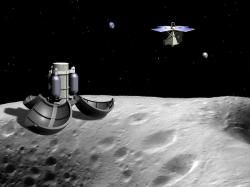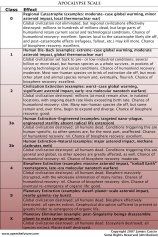Page 12296
Jan 23, 2007
AsteroidShield related news
Posted by Brian Wang in categories: asteroid/comet impacts, lifeboat, space
The New Scientist also has an article about how exploding robots could be sent to determine the composition of Near Earth Asteroids. This would be relevant in developing a proper Asteroid shield. A current project is the Lifeboat AsteroidShield

An illustration from Ball Aerospace and New Scientist.
The Ball Aerospace proposal of many small probes seems cost efficient and worthy of being advocated by the Lifeboat Foundation.
Jan 23, 2007
Prospects for Lifeboat space habitat colonies
Posted by Brian Wang in categories: lifeboat, nuclear energy, space
The New Scientist discusses a recent study that advocates using of an ion beam generator on the moon to allow the use of far smaller rockets to move from the moon to other locations in space. The ion beam generator would need several hundred megawatts of electrical power from either a large solar cell array or nuclear power.
I have discussed the need on my website to make gigawatts of power on the moon and in orbit in order to begin serious development and colonization efforts.
An alternative to ion beams would be magbeam, a plasma based approach for accelerating spaceships
The Lifeboat Foundation supports space habitats and Asteroid shields
Continue reading “Prospects for Lifeboat space habitat colonies” »
Jan 21, 2007
Significant Nanotechnology related developments
Posted by Brian Wang in category: nanotechnology
There were several significant developments and announcements that were nanotechnology related.
The UK Ideas Factory Sandpit announced three ambitious, but in my opinion achievable projects in the 2–5 year timeframe.
1. A system with software based control for the assembly of DNA oligomers, nanopartices and other small molecules. This would be a significant advance over current DNA synthesis if they are successful.
Continue reading “Significant Nanotechnology related developments” »
Jan 19, 2007
Militarization of Space Looming
Posted by Michael Anissimov in categories: military, space
On CNN:
WASHINGTON (CNN) — China last week successfully used a missile to destroy an orbiting satellite, U.S. government officials told CNN on Thursday, in a test that could undermine relations with the West and pose a threat to satellites important to the U.S. military.
According to a spokesman for the National Security Council, the ground-based, medium-range ballistic missile knocked an old Chinese weather satellite from its orbit about 537 miles above Earth. The missile carried a “kill vehicle” and destroyed the satellite by ramming it.
From JTA News:
House resolution calls for Ahmadinejad genocide charges
A bipartisan slate of lawmakers in the U.S. House of Representatives proposed a resolution calling on the Iranian president to face genocide incitement charges.
Jan 15, 2007
U.S. developing nanotech military armor
Posted by Michael Anissimov in categories: military, nanotechnology
From United Press International:
DAYTON, Calif., Dec. 20 (UPI) — The U.S. Army awarded a $15 million contract for the development of a new type of lightweight composite armor based on nanotechnology.
The pact awarded to the University of Dayton Research Institute (UDRI) this week will lead to new materials that can be used in vehicles and body armor.
“This is not a ground-level academic study project,” UDRI engineer Brian Rice said. “We are actually working with two Ohio companies to create a product that, if it tests out well, could show up in Iraq next year.”
Continue reading “U.S. developing nanotech military armor” »
Jan 14, 2007
Scientists to Move Doomsday Clock Forward
Posted by Michael Anissimov in category: nuclear weapons
From NewsMax.com:
The keepers of the “Doomsday Clock” plan to move its hands forward next Wednesday to reflect what they call worsening nuclear and climate threats to the world.
Continue reading “Scientists to Move Doomsday Clock Forward” »
Jan 11, 2007
State of Existential Risk in 2007
Posted by Michael Anissimov in category: existential risks
An existential risk is a global catastrophic risk that threatens to exterminate humanity or severely curtail its potential. Existential risks are unique because current institutions have little incentive to mitigate them, except as a side effect of pursuing other goals. There is little to no financial return in mitigating existential risk. Bostrom (2001) argues that because reductions in existential risks are global public goods, they may be undervalued by the market. Also, because we have never confronted a major existential risk before, we have little to learn from, and little impetus to be afraid. For more information, see this reference.
There are three main categories of existential risk — threats from biotechnology, nanotechnology, and AI/robotics. Nuclear proliferation itself is not quite an existential risk, but widespread availability of nuclear weapons could greatly exacerbate future risks, providing a stepping stone into a post-nuclear arms race. We’ll look at that first, then go over the others.
Nuclear risk. The risk of nuclear proliferation is currently high. The United States is planning to spend $100 billion on developing new nuclear weapons, and reports suggest that the President is not doing enough to curtail nuclear proliferation, despite the emphasis on the War on Terror. Syria, Qatar, Egypt, and the United Arab Emirates met to announce they their desire to develop nuclear technology. North Korea successfully tested a nuclear weapon in October. Iran continues enriching uranium against the will of the United Nations, and an Iranian official hinted that the country may be obtaining nuclear weapons. Last night, President Bush used the most confrontational language yet towards Iran, accusing it of directly providing weapons and funds to combatants killing US soldiers. The geopolitical situation today with respect to nuclear technology is probably the worst it has been since the Cold War.
Biotechnological risk. The risk of biotechnological disaster is currently high. An attempt among synthetic life researchers to formulate a common set of ethical standards, at the International Conference on Synthetic Biology, has failed. Among the synthetic biology and biotechnology communities, there is little recognition of the risk of genetically engineered pathogens. President Bush’s plan to spend $7.1 billion on bird flu vaccines was decreased to $2.3 billion by Congress. There is little federal money being spent on research to develop blanket countermeasures against unanticipated biotechnological threats. There are still custom DNA synthesis labs that fill orders without first scanning for harmful sequences. Watch-lists for possible bioweapon sequences are out of date, and far from comprehensive. The cost of lab equipment necessary to make bioweapons has decreased in cost and increased in performance, putting it within the financial reach of terrorist organizations. Until there is more oversight in this area, the risk will not only remain, but increase over time. For more information, see this report.
From MIT’s Technology Review:
Researchers at the University of Twente, in the Netherlands, have developed an ultrasensitive sensor that could potentially be used in a handheld device to, within minutes, detect various viruses and measure their concentration. The sensor could be used to quickly screen people at hospitals and emergency clinics to control outbreaks of diseases such as SARS and the bird flu. All it would take is a tiny sample of saliva, blood, or other body fluid.
Currently available methods to detect viruses are also sensitive. But they require laborious preparation of the fluid sample and only give results after several days. Since viral diseases can spread rapidly, researchers are looking for easier, faster ways to directly detect viruses. “You want a tool on which you apply the [fluid] sample on-site and in a few minutes say whether or not the person has the SARS virus,” says Aurel Ymeti, a postdoctoral researcher in biophysical engineering and the sensor’s lead developer.
Looks promising. Hopefully this model can be extended to other nanoscale threats, like prions and genetically engineered viruses.









